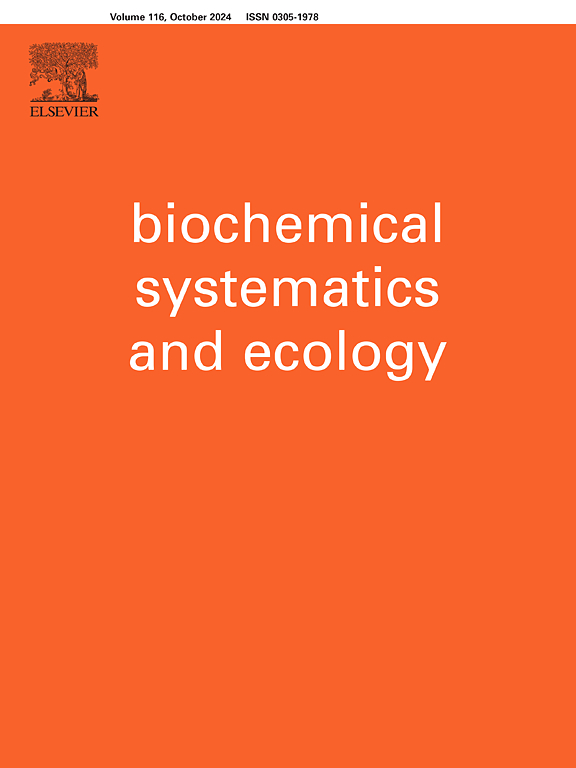Investigation of an endophytic Streptomyces sp. from the liverwort Bazzania trilobata: A new source for abyssomicins
IF 2
4区 生物学
Q4 BIOCHEMISTRY & MOLECULAR BIOLOGY
引用次数: 0
Abstract
Liverworts are the most ancient group of land plants and share intimate symbioses with microorganisms, yet their endophytes have remained unexplored as a source of unique compounds. As part of an ongoing search for novel and bioactive compounds from microbial associates of liverworts, an endophytic Streptomyces sp. LH003 cultured from Bazzania trilobata was identified as a new source for abyssomicins. Three compounds, namely abyssomicin 2 (1), abyssomicin 4 (2), and neoabyssomicin B (3) were isolated from the crude ethyl acetate extract of the endophytic Streptomyces sp. fermentation culture using sem-preparative HPLC. The chemical structures of the compounds were established using 1D and 2D NMR, HRESIMS, UV, ECD, and by comparison to published data. This work represents the first study of an endophyte obtained from the liverwort B. trilobata, and the first report of isolated metabolites from a liverwort-associated endophytic bacterium. The discovery of abyssomicins from this unique microbial source broadens the known ecological and taxonomic distribution of these compounds. The production of known antibacterial metabolites by an endophytic bacterium may have implications for microbial interactions within the liverwort. Additionally, this study discusses the distribution pattern of known abyssomicins across different bacterial genera, highlighting the distinct biosynthetic origins of these compounds.

三叶棘球藻内生链霉菌的研究:一种新的深海菌素来源
Liverworts是最古老的陆地植物群,与微生物有着密切的共生关系,但它们的内生菌作为一种独特化合物的来源仍未被探索。作为正在进行的从苔类微生物伴生物中寻找新的生物活性化合物的一部分,从三叶巴兹ania trilobata培养的内生Streptomyces sp. LH003被确定为深渊菌素的新来源。采用半制备高效液相色谱法从内生链霉菌发酵培养物的乙酸乙酯粗提取物中分离得到3个化合物,分别为abyssomicin 2(1)、abyssomicin 4(2)和neoabyssomicin B(3)。化合物的化学结构通过1D和2D NMR, hresms, UV, ECD以及与已发表数据的比较来确定。这项工作是对从三叶藻中获得的内生菌的首次研究,也是对从一种与苔相关的内生细菌中分离出的代谢物的首次报道。从这种独特的微生物来源中发现的深渊菌素拓宽了这些化合物已知的生态和分类分布。一种内生细菌产生的已知抗菌代谢物可能对苔内微生物的相互作用有影响。此外,本研究讨论了已知的abyssomicins在不同细菌属中的分布模式,突出了这些化合物的独特生物合成起源。
本文章由计算机程序翻译,如有差异,请以英文原文为准。
求助全文
约1分钟内获得全文
求助全文
来源期刊

Biochemical Systematics and Ecology
生物-进化生物学
CiteScore
3.00
自引率
12.50%
发文量
147
审稿时长
43 days
期刊介绍:
Biochemical Systematics and Ecology is devoted to the publication of original papers and reviews, both submitted and invited, in two subject areas: I) the application of biochemistry to problems relating to systematic biology of organisms (biochemical systematics); II) the role of biochemistry in interactions between organisms or between an organism and its environment (biochemical ecology).
In the Biochemical Systematics subject area, comparative studies of the distribution of (secondary) metabolites within a wider taxon (e.g. genus or family) are welcome. Comparative studies, encompassing multiple accessions of each of the taxa within their distribution are particularly encouraged. Welcome are also studies combining classical chemosystematic studies (such as comparative HPLC-MS or GC-MS investigations) with (macro-) molecular phylogenetic studies. Studies that involve the comparative use of compounds to help differentiate among species such as adulterants or substitutes that illustrate the applied use of chemosystematics are welcome. In contrast, studies solely employing macromolecular phylogenetic techniques (gene sequences, RAPD studies etc.) will be considered out of scope. Discouraged are manuscripts that report known or new compounds from a single source taxon without addressing a systematic hypothesis. Also considered out of scope are studies using outdated and hard to reproduce macromolecular techniques such as RAPDs in combination with standard chemosystematic techniques such as GC-FID and GC-MS.
 求助内容:
求助内容: 应助结果提醒方式:
应助结果提醒方式:


